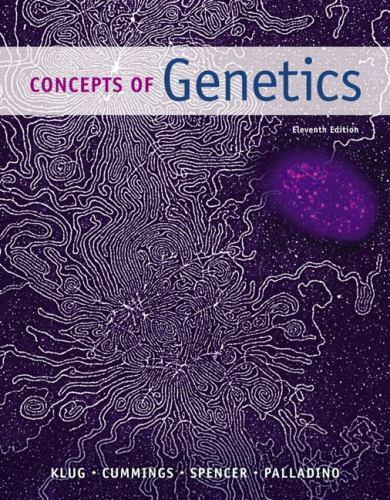
Concepts of Genetics 11th Edition by William Klug,Michael Cummings,Charlotte Spencer,Michael Palladino
Edition 11ISBN: 9781292139456
Concepts of Genetics 11th Edition by William Klug,Michael Cummings,Charlotte Spencer,Michael Palladino
Edition 11ISBN: 9781292139456 Exercise 1
Describe Mendel's conclusions about how traits are passed from generation to generation.
Explanation
Mendel planted the garden peas and observed the changes in their characteristics for different generations. His quantitative observations were later calculated into ratios. He calculated the ratios of different physical characteristics of the offspring. He concluded that offspring inherit the physical characteristics from their parents.
During Mendel time, the concept of chromosomes, genes and alleles are not known. Hence, Mendel coined the term hereditary factor for alleles. Hereditary factor is a unit of inheritance. Pair of alleles together encodes a character. Now-a-days, the genes are called hereditary units.
According to Mendel, each parent contributes one hereditary factor for a trait to the offspring. Hence, the offspring receives two hereditary factors from both the parents to express a trait. For example, one pea plant receives two hereditary factors for seed color. The color of the seed depends on the type of hereditary factor that a plant received from its parents.
According to the Mendel, the dominant alleles will be expressed, while the recessive alleles will be hidden. For example, if yellow is the dominant seed color and green is the recessive seed color. A plant with yellow seed allele and a green seed allele will express yellow seed color. Thus, it proves the dominant alleles offset the effects of the recessive alleles.
Hence, by conducting several experiments on garden pea plants Mendel proved that the traits are carried from generation to generations. He also compared the records of his experiments to perform calculations in favor of his statements.
During Mendel time, the concept of chromosomes, genes and alleles are not known. Hence, Mendel coined the term hereditary factor for alleles. Hereditary factor is a unit of inheritance. Pair of alleles together encodes a character. Now-a-days, the genes are called hereditary units.
According to Mendel, each parent contributes one hereditary factor for a trait to the offspring. Hence, the offspring receives two hereditary factors from both the parents to express a trait. For example, one pea plant receives two hereditary factors for seed color. The color of the seed depends on the type of hereditary factor that a plant received from its parents.
According to the Mendel, the dominant alleles will be expressed, while the recessive alleles will be hidden. For example, if yellow is the dominant seed color and green is the recessive seed color. A plant with yellow seed allele and a green seed allele will express yellow seed color. Thus, it proves the dominant alleles offset the effects of the recessive alleles.
Hence, by conducting several experiments on garden pea plants Mendel proved that the traits are carried from generation to generations. He also compared the records of his experiments to perform calculations in favor of his statements.
Concepts of Genetics 11th Edition by William Klug,Michael Cummings,Charlotte Spencer,Michael Palladino
Why don’t you like this exercise?
Other Minimum 8 character and maximum 255 character
Character 255


